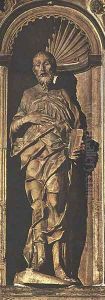Cristoforo Mantegazza Paintings
Cristoforo Mantegazza was an Italian sculptor and architect, born in 1430 in Pavia, Lombardy, during the early Renaissance period. His work is emblematic of the transition from the Gothic to the Renaissance style, reflecting the changing tastes and philosophical outlooks of the era. Mantegazza is particularly noted for his elaborate marble sculptures and intricate architectural decorations that combine a delicate Gothic sensibility with the emerging principles of Renaissance clarity and proportion.
Much of Mantegazza's career was spent working on the Certosa di Pavia, a grand monastery complex located near his hometown. This project, which was initiated by the Visconti family, rulers of Milan, provided a crucial platform for Mantegazza to develop and showcase his skills. His contributions to the Certosa include finely sculpted reliefs and statues that adorn the facade and cloisters, characterized by their vivid expression and detailed craftsmanship. These works are celebrated for their dynamic compositions and the lifelike quality of the figures, demonstrating Mantegazza's mastery of human anatomy and his ability to convey complex emotions through stone.
Despite his considerable contributions to the Renaissance art movement, Cristoforo Mantegazza remains a somewhat obscure figure, often overshadowed by his more famous contemporaries. However, his work at the Certosa di Pavia and other sites in Lombardy are critical to understanding the artistic transition of the period. Mantegazza's legacy lies in his innovative approach to sculpture and architecture, blending gothic intricacy with the emerging renaissance emphasis on harmony and proportion. He passed away in 1482, leaving behind a body of work that continues to be studied and admired for its artistic significance and historical importance.
